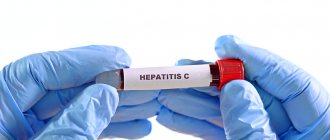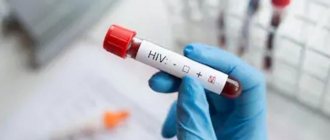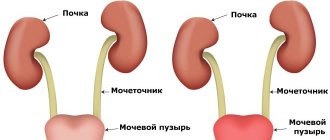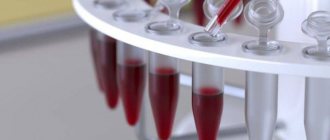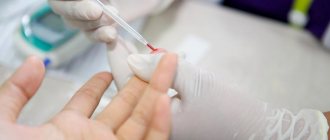STD
An enzyme immunoassay for syphilis is one of the most common methods for identifying sexually transmitted diseases.
The list of standard diagnostic measures used for infectious diseases includes enzyme immunoassay. If the ELISA is positive for syphilis, do not immediately panic.
Let us take a closer look at the features of this research technique and the principles for interpreting the results obtained in different categories of patients.
- The essence of the study
- Advantages and disadvantages
- Indications for use
- Methods of carrying out Rules for collecting material
- Methodology
What is ELISA for syphilis
ELISA for syphilis - an affordable and highly informative test
ELISA is an enzyme-linked immunosorbent assay used as a highly sensitive test in the diagnosis of various pathologies, including syphilis. Allows you to identify the disease and determine its stage as accurately as possible.
Syphilis occurs when the bacterium Treponema pallidum (Treponema pallidum) enters the body. After 2 - 4 weeks, a hard chancre forms on the skin in the localization where the penetration occurred; most often, a papule characteristic of syphilis is formed on the genitals, which means the initial stage of primary syphilis. As the disease progresses, the papules transform into ulcers and then disappear in most cases, giving the patient false hope of self-healing. But the latent period passes into the stage of secondary syphilis, while treponemes spread throughout the body, penetrating tissues and organs. Multiple rashes form on the skin and mucous membranes. In the absence of treatment, the next stage occurs - tertiary syphilis with the formation of gummas and damage to the central nervous system, heart, bone tissue, gastrointestinal tract, oral cavity and other organs.
Detection of antibodies confirms infection
ELISA determines primary, secondary, tertiary (most often only at the initial stage), congenital, recurrent and latent syphilis. The essence of the method is to detect antibodies that the body produces in response to the introduction of treponema. At the initial stage of the disease, class M antibodies are formed, after a few weeks they are joined by class G immunoglobulins. The concentration of certain antibodies varies depending on the stage of development of syphilis, which makes it possible to determine the stage of the disease. When performing ELISA, true Treponema pallidum or its antigens are used, so the test is classified as a treponemal assay.
Unlike non-treponema tests, in which treponema analogues act as antigens, ELISA has a minimal number of false results.
Cost of enzyme immunoassay
As a rule, the cost of this analysis directly depends on the analysis itself and the detection of a specific infection. Determining markers for infection of various types costs from 200 to 350 rubles. And such an analysis is carried out within two days.
ELISA is the most popular and modern method of diagnosing the body. The method has shown to be effective in detecting infection and determining the exact period of infection.
Considering the pricing policy, we can say that the analysis is available to everyone with any budget. It allows the attending physician to obtain a complete picture of a person’s infection. He proved himself in action and did not disappoint the doctors. At the same time, having received the analysis, the attending physician could react promptly, prescribing treatment in a timely manner.
Advantages and disadvantages of the method
Any research method is not without its drawbacks
Previously, various methods were used in the diagnosis of syphilis, such as: RPHA (passive hemagglutination reaction), RW (Wassermann reaction), MR (precipitation microreaction), RSK (complement fixation reaction) and other tests. The variety of tests used as screening tests and the lack of a unified system often led to confusion and, as a result, to negative consequences, for example, when a donor with a false negative result became an intermediary in infecting recipients. Since 2006, testing has become more standardized, ELISA has been recognized as one of the most effective diagnostic methods and is now used as a screening test when a positive non-treponemal test is detected.
Nontreponemal tests are screening tests
Now non-treponemal tests are used to detect possible syphilis infection in all groups of the population, that is, they are screening tests. If the result is questionable or positive, an ELISA or other treponemal analysis is prescribed. ELISA has become one of the leading tests for syphilis due to its advantages:
- high sensitivity, allowing detection of antibodies to treponema in very low concentrations;
- high specificity is achieved through the use of Treponema pallidum antigens;
- objectivity of results thanks to automatic accounting;
- the ease of setting up the reaction is achieved thanks to the complete set of diagnostic kits;
- universality of the test: can be used for preventive examination of the population, for diagnosing all stages of the disease and checking doubtful results.
Antibodies to Treponema pallidum are similar to some types of immunoglobulins produced during other types of infection, therefore, despite the specificity of ELISA, false-positive results can be detected in small quantities. Another disadvantage of ELISA is that as the disease progresses, the number of antibodies decreases, which can lead to a false negative result.
Also, the ELISA result cannot act as a single indicator for diagnosing syphilis, but is used in conjunction with other studies, which does not allow it to be called an accurate marker of the disease.
The disadvantages of the test include its relative high cost.
Laboratory diagnostic method
Medicine does not stand still; modern tests have become significantly different from old methods of studying the body. Although they performed their role perfectly, sometimes they had to wait weeks and months for results. This naturally was not beneficial for the infected person. What is waiting for a result? A sick person experienced it himself.
Classic tests - detecting syphilis using the Wasserman method, the Kahn method - began to lose their positions and were replaced by tests such as ELISA.
This is the most modern method for detecting infection in humans. The result is decrypted using a computer. This allows you to more accurately determine a positive or negative result.
Indications for the study.
Pregnancy period - indication for analysis
ELISA is performed as a confirmatory test after non-treponemal analysis, but can also act as a screening test. Prescribed in the following cases:
- planned testing when applying for certain types of work;
- routine identification of infection risk;
- hospitalization, preoperative period;
- donation;
- pregnancy;
- examination for symptoms of syphilis.
Syphilis can be suspected based on a specific symptom - the formation of a hard chancre, as well as pain in the joints and bones, swelling of the genitals, an increase in body temperature to 38 ° C, and enlarged lymph nodes. As a preventive measure, it is recommended to undergo testing regularly during an active sexual life with a change of partners.
What to do in case of false positive reactions?
When a person’s diagnosis of a syphilitic infection is not confirmed in subsequent tests, this causes him joy and relief.
Most thank the doctor and go home, forgetting about hospitals and examinations for a long time.
But this approach is wrong.
After all, if a patient has false negative test results, this means that he is highly likely to have certain diseases.
In healthy and non-pregnant people, positive reactions in the absence of syphilis are rare.
Therefore, it is advisable to be examined to find out the cause.
Often such patients have systemic connective tissue diseases, tumors or infections.
Therefore, it is advisable to be examined for STDs, undergo general clinical tests, and undergo cancer screening.
The doctor decides what kind of research is needed.
In doing so, he is guided by the presenting symptoms, anamnestic data and the results of general clinical laboratory tests.
Preparing for the study
During a hectic period, you should refrain from taking the test.
To minimize the risk of obtaining a false result, you should follow the rules.
- The blood sample is given on an empty stomach; depending on the laboratory, the fasting period should range from 4 to 12 hours.
- In the previous day, alcohol and fatty foods are excluded, smoking is limited at least an hour before the test.
- On the eve of the analysis, you can only drink clean water; drinking juices, coffee, and medications is not allowed.
- All other studies and medical procedures are carried out after passing the test.
- You should not take the test if you have had a fever or been vaccinated in the previous days.
- Women are not recommended to take the test during their period.
Serological tests at different periods of the disease
Tests are divided into:
- Treponemal tests (ELISA, RPGA, RIF, immunoblotting) are an accurate and expensive method. The study uses specific antigens that react directly to the pathogen, that is, Treponema pallidum.
- Non-treponemal (RW, RPR, RMP) - an analogue of the microorganism is used for research - the caridiolipin antigen. These tests are cheaper and use them to quantify antibodies to syphilis, and not just their presence. They react to nonspecific antibodies - IgM and IgG. These tests are indicated if it is not known whether an individual is sick or not. However, the results may be false positive; a treponemal test is prescribed for confirmation.
The research results depend on the period of the disease:
- Primary – after a different number of days, both types of tests become positive. If the disease is suspected, diagnosis is made using PCR, or serological tests are repeated again after two weeks.
- Secondary – all tests are positive, in this period the number of antibodies is the largest.
- Tertiary - treponemal tests are positive, and non-treponemal tests are negative due to the fact that IgM antibodies disappear from the blood.
- After successful treatment of syphilis, antibodies in non-treponemal tests decrease. One and a half years after the start of therapy, these tests should be negative. Treponemal - remain positive.
Decoding the results
A positive result indicates the presence of the virus
Positive result:
- presence of Treponema pallidum infection;
- false positive result in the presence of other factors;
- consequences of previously cured syphilis.
Negative result:
- absence of infection;
- incubation (early primary) period of syphilis;
- late period, including late stages of development of tertiary syphilis.
Classification of syphilis
The following types of syphilis are distinguished:
- Early – lasts on average about two years. There are several periods of the disease: incubation, primary, secondary. Timely started therapy brings a noticeable effect. Complications are reversible.
- Late - has one tertiary period. The remaining pathogens provoke allergic manifestations that are destructive to the body. Under the influence of the disease, the immune system begins to rebuild. Trying to protect themselves from bacteria, protective cells form seals around them, so-called infiltrates, consisting of lymph, blood and cellular tissue of the immune system. Further, purulent processes develop inside such seals, leading to ulcerative formations that damage nearby tissues.
- Hidden - it is revealed based on the results of the study. Antibodies to syphilis are detected in the blood. This type of disease is divided into early - less than two years have passed since the pathogen entered the body, and late - more than two years.
Forms of syphilis:
- Hidden - occurs in the primary and secondary periods.
- Manifested - in the secondary and tertiary.
False positive result and its causes
A false positive test may occur in diabetes mellitus
Treponema pallidum is a spirochete containing 42 gene families, 17% of which are similar to proteins of other types of bacteria, which in a small number of cases provokes a positive result in the presence of infection with other microorganisms. For example, in a number of autoimmune diseases, antiphospholipid antibodies are detected, similar to the antibodies in syphilis. At the turn of the 21st century, it was found that in this case the difference between antibodies lies in the dependence factor; in autoimmune diseases, antibodies are dependent on p2-glycoprotein-1, while in syphilis they are not dependent. But today the question of the occurrence of false-positive reactions remains open, since the reason for such results is not always clear.
Some false indicators are chronic and can accompany a person for decades.
According to statistics, false positive results most often occur in the following cases:
- hepatitis;
- leprosy;
- myocardial infarction;
- intoxication;
- connective tissue diseases;
- autoimmune pathologies;
- diabetes;
- pregnancy;
- menstruation period;
- post-vaccination period.
Treponema is similar to other pathogens
Treponema pallidum is not the only type of trepanema; other spirochetes are also pathogenic: Treponema pertenue (causative agent of java), Treponema bejel (pathogen of bejel), Treponema carateum (causative agent of pint) and many others. Upon microscopic examination, they differ little from treponema pallidum, and antibodies against them are similar to immunoglobulins for syphilis.
A positive result may reflect the presence of the disease in the past, since immunoglobulins G can linger in the bloodstream for years.
How to decipher the result of a nonspecific examination
A transcript of a syphilis test performed using nonspecific tests may contain:
- four crosses (++++), meaning a sharply positive sample;
- three crosses (+++) – positive reaction;
- two crosses (++) – weakly positive test;
- one cross (+) – negative or questionable result;
- designation with a minus sign (-) – there is no disease.
How to understand the results of a specific study
When using an immunofermentation reaction (ELISA), immunoglobulins are determined in the patient’s blood (designations IgM, IgA, IgG):
- If IgA is detected, we can talk about a recent infection that occurred about two weeks ago.
- Detection of immunoglobulins class A and M makes it possible to determine the first stage of the disease and the end of the incubation period.
- Receiving three types of antibodies of classes A, M, G at once indicates the progression of syphilis and the body’s fight against infection.
- When IgG is detected, it makes sense to talk about the cure of syphilis and proper therapy.
Test results can be expressed as percentages:
- 20% – negative;
- 20-30% – doubtful;
- 30-50% – weakly positive;
- more than 50% – positive analysis.
Not all people who receive the research results are able to decipher the numbers presented as a ratio. If the form shows values of 1:2 - 1:800, it is too early to talk about infection.
In some patients who have undergone therapy, antibodies are detected for a long period.
If they grow, the doctor suspects the presence of a pathogenic pathogen in the patient’s body. Titers decrease with proper treatment.
How long do antibodies circulate in the blood?
The peculiarity of antibodies (protective proteins) is that even after proper treatment with antibacterial agents, they do not completely disappear, although their number is significantly reduced. This phenomenon worries individuals, as they want to quickly forget and not remember this unpleasant pathology. Doctors warn in advance that total antibodies to syphilis remain in the blood of a person who has been ill for a long period. After early stage treatment, they go away in about two years, and types of tests such as RPR, RW, RMP will give a negative result. After late syphilis, they remain for life, and in some individuals they may disappear after a few years. This is explained by the following reasons:
- Particles of dead pathogens (treponema) are present in the body for a long period. As long as they remain, the synthesis of protective cells will continue.
- The individual characteristics of the immune system also play an important role. In some individuals their synthesis stops earlier, while in others it stops later.
It should be remembered that you cannot completely get rid of antibodies after syphilis, and this should not be done, since these cells are harmless.
Syphilis causes serious complications, but they develop rather slowly. Therefore, the individual has time to undergo examination and, if the diagnosis is confirmed, treatment, i.e., until the consequences become irreversible.
Antibodies to the causative agent of syphilis: immunoglobulins (IgM, IgG, IgA)
Antibodies, or immunoglobulins, are synthesized in the body to fight the pathogen. Each of the proteins is different in structure, carries specific information and has its own purpose:
- Immunoglobulins A are early antibodies and are responsible for local immunity. Quite a lot of them are synthesized in the mucous membrane of the mouth, intestines, and respiratory organs, and a small amount is synthesized in the blood. These antibodies appear in the first weeks of infection, their detection indicates the presence of inflammation, they are nonspecific and are able to react to various bacteria that penetrate the body, therefore they are practically not used to diagnose syphilis.
- Immunoglobulins M - also belong to early antibodies to syphilis, but are responsible for general immunity in the body, i.e., for the entire protective system. They are characterized as weakly specific. They are synthesized two weeks after the introduction of the pathogen. They can be identified in five to six weeks. Their production occurs in the primary and secondary periods, and in the tertiary period they disappear. Detection of IgM is a sign of the active stage of the disease.
- Immunoglobulins G are late protein-specific compounds that appear four to five weeks after infection. The body remembers them and continues to produce them for a long time after pharmacotherapy. However, they do not protect an individual from re-infection.
If you do a study for each class of antibodies to syphilis using an ELISA test, then the results are interpreted as follows:
- the pathogen has been present in the body for less than two weeks, IgA is detected;
- infection occurred less than four weeks ago – IgA and IgM;
- the infection occurred more than four weeks ago - all types of proteins are detected: IgA, IgM and IgG;
- late syphilis or effectively treated - IgG.
The appearance of false results in the absence of syphilis
False-positive reactions are when tests show the presence of antibodies to the pallidum spirochete in a person who has never had syphilis and does not currently suffer from this disease.
There are three groups of reasons for such reactions:
- the presence of other infections in which bacteria have a similar antigenic structure;
- diseases not associated with infectious diseases that provoke the release of autoantigens;
- technical errors or errors of medical personnel.
False-positive reactions can be acute or chronic.
The latter remain positive for over six months.
The main causes of acute false-positive tests:
- pregnancy;
- pneumonia;
- Epstein-Barr virus;
- recent vaccination;
- constant use of alcohol;
- tuberculosis.
Causes of chronic reactions:
- systemic lupus erythematosus;
- autoimmune thyroiditis;
- rheumatic diseases;
- cancer;
- hypertonic disease;
- tuberculosis;
- addiction.
In drug addicts, positive reactions to reagin can persist for more than a year after stopping drug use.
In women, false positive reactions are observed almost 5 times more often.
Age is also a significant risk factor.
The older a person is, the more likely they are to be misdiagnosed with syphilis.
Most often, false positive reactions can be recognized.
They are weakly positive.
In quantitative studies they have low antibody titers.
Although in some cases it can be high.
Strongly positive and at the same time false reactions to the pale spirochete are possible for the following reasons:
- lymphoma;
- chronic leukemia;
- diffuse connective tissue lesions;
- hepatocellular carcinoma.
In this case, differential diagnosis is carried out by performing analyzes over time.
With untreated syphilis, the antibody titer usually increases.
In other pathologies it decreases.
The most reliable way to confirm the diagnosis is to perform reactions that are based on the determination of IgM.
These tests are the most specific for syphilitic infection.
How is syphilis diagnosed?
The diagnosis of syphilis is made on the basis of a combination of history, confrontation, clinical picture and laboratory data, including detection of the pathogen and the results of a serological examination. Confirmation of the diagnosis by laboratory data is mandatory.
| In case of complete inability to use laboratory diagnostic methods for syphilis, the World Health Organization (1999) and the Ministry of Health of the Russian Federation (order No. 327 of July 25, 2003) allow the use of so-called syndromic (epidemiological) treatment of syphilis based on clinical and anamnestic data. |
Diagnostic methods confirming the presence of syphilis
| Name | Method of carrying out | Confirmatory signs |
| Anamnesis | Questioning the patient | Confirmed diagnosis of syphilis in a sexual partner Casual sexual intercourse without barrier protection during the period corresponding to the incubation period Previous presence of rashes in the genital area, enlarged lymph nodes |
| Clinical examination | Inspection of the genital organs, skin, oral mucosa, anus Palpation of eruptive elements if present Palpation of peripheral lymph nodes | The presence of skin and mucous membrane lesions characteristic of different periods of syphilis. Enlarged lymph nodes |
| Detection of T. pallidum in material from lesions, lymph nodes, amniotic fluid, cerebrospinal fluid | Dark-field microscopy | Detection of typical forms of treponema |
| Direct immunofluorescence reaction (RIF-Tr) | Presence of fluorescent treponemes | |
| Polymerase chain reaction PCR | Detection of T. pallidum specific DNA | |
| Non-treponemal serological tests - detection in blood serum of antibodies against phospholipids of tissues destroyed by syphilitic infection and membrane lipids of T. pallidum | Macroscopic test Rapid Plasma Reagins (RPR) test | Positive (positive) result |
| Microscopic test VDRL (Venereal Disease Research laboratory) Quantitative test VDRL | ||
| Compliment binding reaction (Wassermann reaction) | ||
| Treponemal serological tests - detection of antibodies against Treponema pallidum antigens in blood serum | Immunofluorescence reaction RIF (FTA) | Positive (positive) result |
| RPHA passive hemoagglutination test (TPHA) | ||
| Enzyme-linked immunosorbent assay (ELISA) | ||
| Immunoblotting | ||
| Treponema pallidum immobilization reaction RIBT |
Diagnostic methods confirming the presence of various forms and complications of syphilis
| Name | Forms and complications |
| CSF examination | Neurosyphilis |
| X-ray of the aorta, long tubular bones, sternum, skull bones, joints | Early congenital syphilis Late congenital syphilis Tertiary syphilis |
| Audiological examination | Acoustic neuritis Syphilitic labyrinthitis |
| Ophthalmological examination | Optic neuritis Parenchymal keratitis |
Routine research methods are also used - general blood and urine tests, biochemical blood tests, etc.
What is immunoblotting
Immunoblotting (Western blot) to determine specific IgM or IgG is one of the modern and accurate methods for diagnosing syphilis. When performing immunoblotting, T. pallidum undergoes electrophoresis, resulting in the separation of protein immunodeterminants. Then the separated points - blots - are treated with the test serum and antibodies to IgG or IgM, labeled with enzymes or radioactive substances. Certain immunodeterminants identified by immunoblotting are diagnostic signs of syphilis. IgG immunoblotting (IgG Western blot) corresponds in sensitivity and specificity to RIF-abs. IgM immunoblotting (IgM Western blot) is used as a diagnostic test for congenital syphilis.
Interpretation:
- If anticardiolipin antibodies are detected, a “positive” response is given with a titer value. At very low titers, the answer is “doubtful, it is recommended to repeat the study after 10 - 14 days.” Positive: RPR - primary seropositive syphilis (infection occurred 1 - 3 months ago); secondary seropositive syphilis (infection occurred more than 3 months ago); tertiary seropositive syphilis (infection occurred more than 3 - 4 years ago); the first year after treatment of syphilis; seroresistance after treatment of syphilis; APS is probable (if syphilis is excluded). False positive reaction (see interference).
- In the absence of anticardiolipin antibodies, the answer is “negative”. Negative: absence of infection, early primary (seronegative) syphilis cannot be excluded, late tertiary syphilis cannot be excluded.
Sample result (PDF)
RPGA
Found (1596 posts)
venereologist February 13, 2020 / Sergey
Hello. Doctor, 3 months to test for syphilis after sexual intercourse or from the moment an ulcer appears on the penis? open (2 more messages)Last 5:
February 15, 2020 / Sergey
Sergey Kulikov, I went to the police department today. Passed the titles RPR and RPGA
, they did it by lunchtime, both negative. And they didn’t even offer to check how you wrote the contents of the ulcer!
venereologist December 27, 2020 / Lana / Ufa
... before the operation in the high pressure chamber and every time the same thing. IFA total 0.278/0.277, IFALgm negative, IFALgg negative, RPGA
negative, MR negative. They give a negative certificate. I don’t know what to think anymore, why does IFA show such a total figure? I... open
December 29, 2020 / Lana
Doctor, That’s the point when I take the IFA test, in total they say 0.277/0.278 is positive, and the detailed immunoglobulins and RPG
and mr everything is negative. They do this to me at the KVD. What can such an ifa give in total? This is not the first time this has happened for about three years. They say …
infectious disease specialist December 27, 2020 / Lana
… . I’m already confused, I’m taking a screening test at the KVD before the operation ifa in total 0.278/0.277, ifa Lgm negative, Lgg negative, RPGA
negative, MR negative.
And this is the third year with such results. They say if immunoglobulins are negative, then ifa in total... open (1 more message)Last 5:
venereologist December 25, 2020 / Ellina / Moscow
Hello! Please tell me, can an IgM test for syphilis give a false positive result due to possible HIV infection? That is, if at this time... open (4 more messages)Last 5:
December 26, 2020 / Ellina
RPGA
, IgG, RPR - negative. I was in 3 clinics and in the KVD. Everywhere they say that this is a false positive reaction. Possibly due to chlamydia or herpes, if they are in the active stage. please tell me, is this really so? I'm just afraid that if it...
venereologist December 13, 2020 / Irina / Moscow
Ifa total negative, ifa igg,igm negative; RMP is negative; RPG
positive. Is it syphilis? I was never sick, never treated, and had no symptoms. open
venereologist December 4, 2020 / Pooh
Hello, please tell me your opinion on how reliable anonymous tests are, as opposed to passport tests. Thank you. open (5 more messages)Last 5:
December 7, 2020 / Anonymous
Pooh, RMP, IFA, RPR, RPGA
venereologist November 22, 2020 / Irina / Moscow
Analysis for syphilis: Ifa was not detected qualitatively and quantitatively Rmp with cardiolipin antigen negative Rpga
discovered
Do I have syphilis? I have been on IVF protocols for two years, I take this test every month, it has always been negative open
November 22, 2020 / Sergey Kulikov
You need to go to the doctor, get examined, repeat (recheck) the studies ( RPGA
, ELISA summ., RIFabs.) and then decide.
venereologist November 16, 2020 / Anonymous / St. Petersburg
…!In 2010, late neurosyphilis was detected (the diagnosis was made after a puncture). Two courses of treatment with intravenous penicillin were carried out. M/r 4+1/4, RPGA
4+, RIF 4+.Additional treatment in 2011 + puncture again - no changes. Additional treatment in 2013 - all tests without ... open
When is quantitative determination of antibodies to syphilis required?
To confirm the presence of a syphilitic infection in the body, a qualitative study is usually sufficient.
But quantitative tests are also used quite often.
The main purposes of their use:
- differential diagnosis of syphilis and false-positive reactions;
- assessment of the clinical course of the disease;
- tracking therapy results;
- confirmation of cure.
The antibody titer can be assessed over time, with intervals of several weeks.
Its increase indicates the progression of the syphilitic infection.
A decrease in titer without the use of drugs may indicate a false positive test result.
If the titer decreases under the influence of specific therapy, this indicates its effectiveness.

